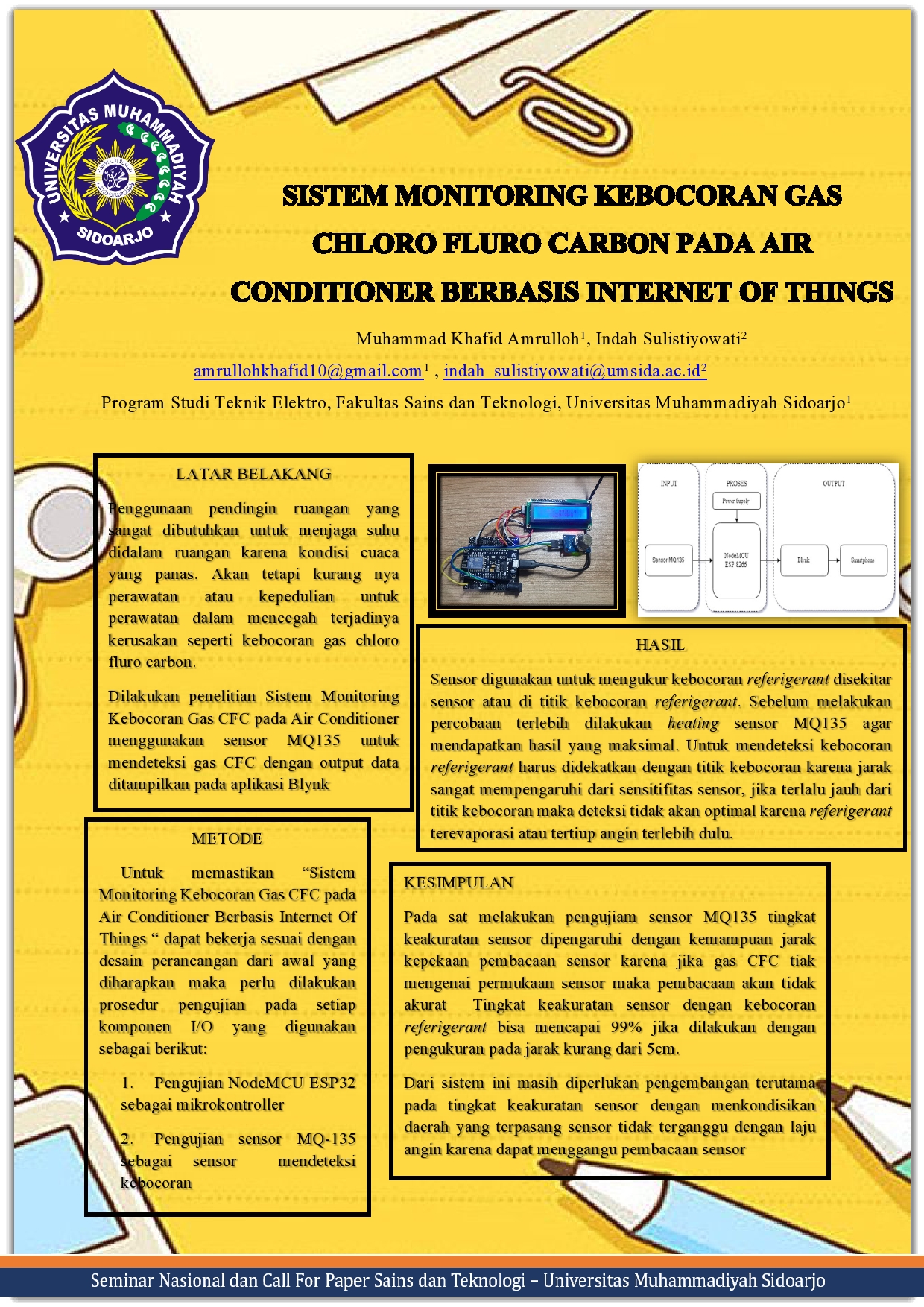Chloro Fluro Carbon Gas Leak Monitoring System in Internet of Things-Based Air Conditioner
Sistem Monitoring Kebocoran Gas Chloro Fluro Carbon Pada Air Conditioner Berbasis Internet of Things
DOI:
https://doi.org/10.21070/pels.v2i2.1232Keywords:
Air Conditioner, Internet of Things, Monitoring System, Sensor MQ-135Abstract
Refrigerant leaks have a major impact on system operating performance, increasing power consumption, damage to components, and worse, global warming. This study aims to use a monitoring system based on the Internet of Things (IoT) to track Chloro Fluro Carbon gas in the air conditioning system. Using NodeMCU as a microcontroller-based control tool that has been assisted by a Wi-Fi module. The sensitivity level of refrigerant leakage is very high based on the sensitivity of the sensor used, namely MQ135. In experimenting, the refrigerant leak starts with the closest distance to the inaccessibility of the sensor readings to determine the acceleration of the sensor in detecting leaks. The voltage required for the MQ135 sensor is 5 Volt DC. This system uses an android application, namely blynk which has features for monitoring and warning users that the AC unit has detected a leak. The results of measuring the sensitivity level of the sensor are very high for alcohol, benzene, and NH3 gases. It can detect small leaks at a distance of 20 cm, at a moderate level of leakage it can detect further at 80 cm, and at a maximum detection level at a distance of 160 cm in closed rooms or low winds. Because the leakage distance is quite far, it will be affected by the wind, the sensor reading will be hampered because the refrigerant cannot hit the sensor.
Downloads
References
H. R. Kurnianto and W. S. Aji, “Sistem Monitoring Gas Chloro Fluro Carbon (CFC) Pada Air Conditioner (AC) Dengan Menggunakan Arduino Dan Sensor MPX5700AP,” Just TI (Jurnal Sains Terap. Teknol. Informasi), vol. 13, no. 1, p. 22, 2021, doi: 10.46964/justti.v13i1.619.
M. S. Aliredjo, Y. A. Nugraha, and I. B. Rahardja, “Design of Refrigerant Leak Detector on Arduino Uno – Based Refrigeration System,” 2020.
I. With, “Designing a Cost Effective and Reliable Pipeline Leak Detection System,” pp. 1–11, 1993.
D. Aziz, “Webserver Based Smart Monitoring System Using ESP8266 Node MCU Module,” Int. J. Sci. Eng. Res., vol. 9, no. 6, p. 801, 2018.
M. F. A. B. Zagita, “Rancang Bangun Sistem Pemantauan Dan Pengendali Kualitas Udara Diruang MI (Manual Insert) PT. Smart Meter,” J. Teknol. Elektro, vol. 12, no. 1, p. 16, 2021, doi: 10.22441/jte.2021.v12i1.004.
M. F. A. Hanur, “Rancang Bangun Alat Pemutus KWH Meter Sebagai Proteksi Berbasis Arduino,” p. 54, 2016.
Y. Oktariani, “Studi Pengaruh Torsi Beban Terhadap Kinerja Motor Induksi Tiga Fase,” Inst. Teknol. Padang, vol. 5, no. 1, pp. 9–15, 2016.
A. Marina, H. K. Ilman, F. Febi, A. E. Muhammad, and I. Muhammad, “Studi Perbandingan Platform Internet of Things (IoT) untuk Smart Home Kontrol Lampu Menggunakan NodeMCU dengan Aplikasi Web Thingspeak dan Blynk,” J. Fidel., vol. 2, no. 1, pp. 59–78, 2020.
A. N. F, J. Raju, and V. Varsha, “An IoT Based Approach To Minimize And Monitor Air Pollution Using ESP32 and Blynk Platform,” J. Xi’an Univ. Archit. Technol., vol. XII, no. Vi, pp. 558–566, 2020.
F. Matematika, D. A. N. Ilmu, P. Alam, and U. S. Utara, “Sistem Monitoring Kebocoran Gas Menggunakan ESP8266 Berbasis Web,” 2019.




